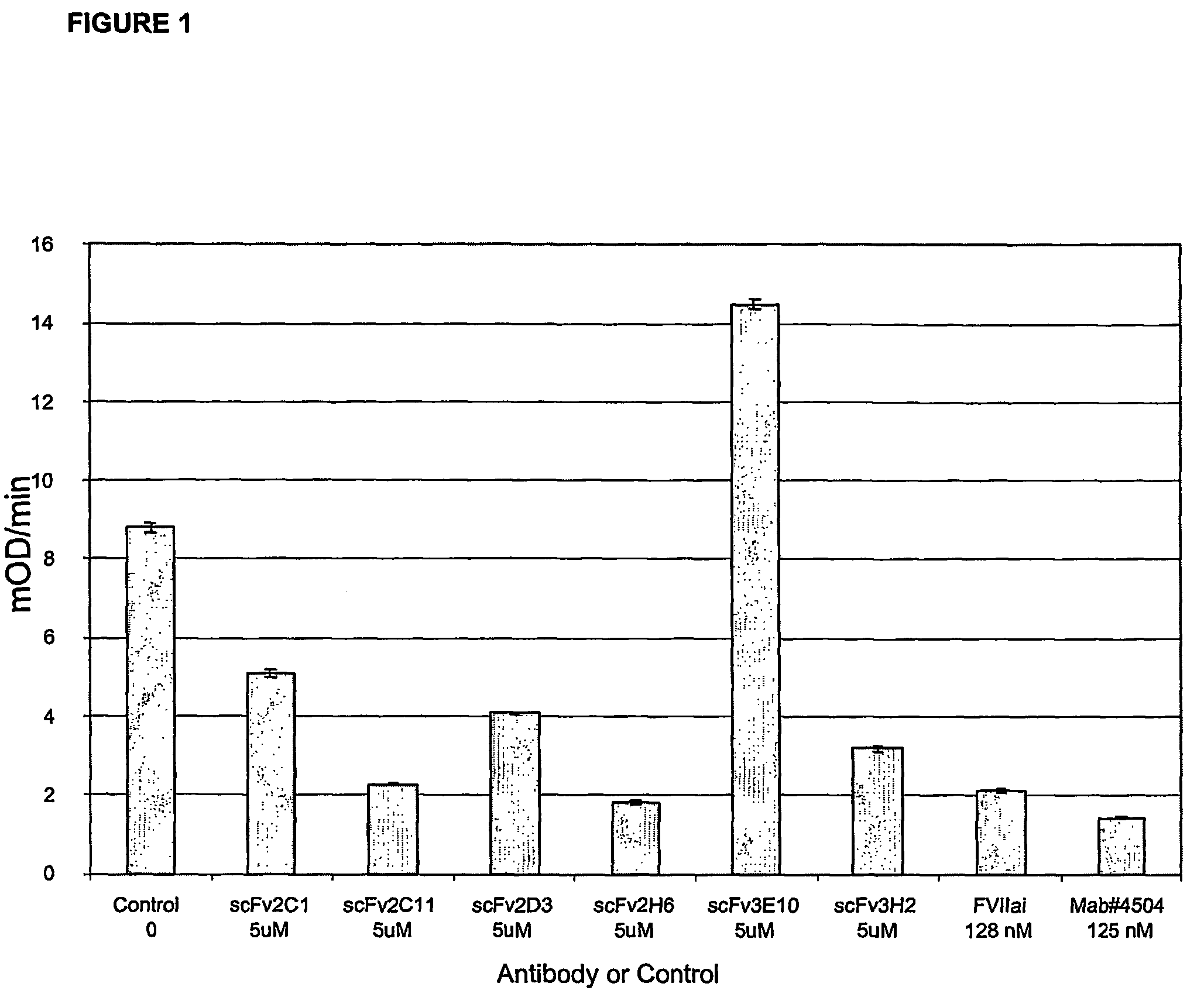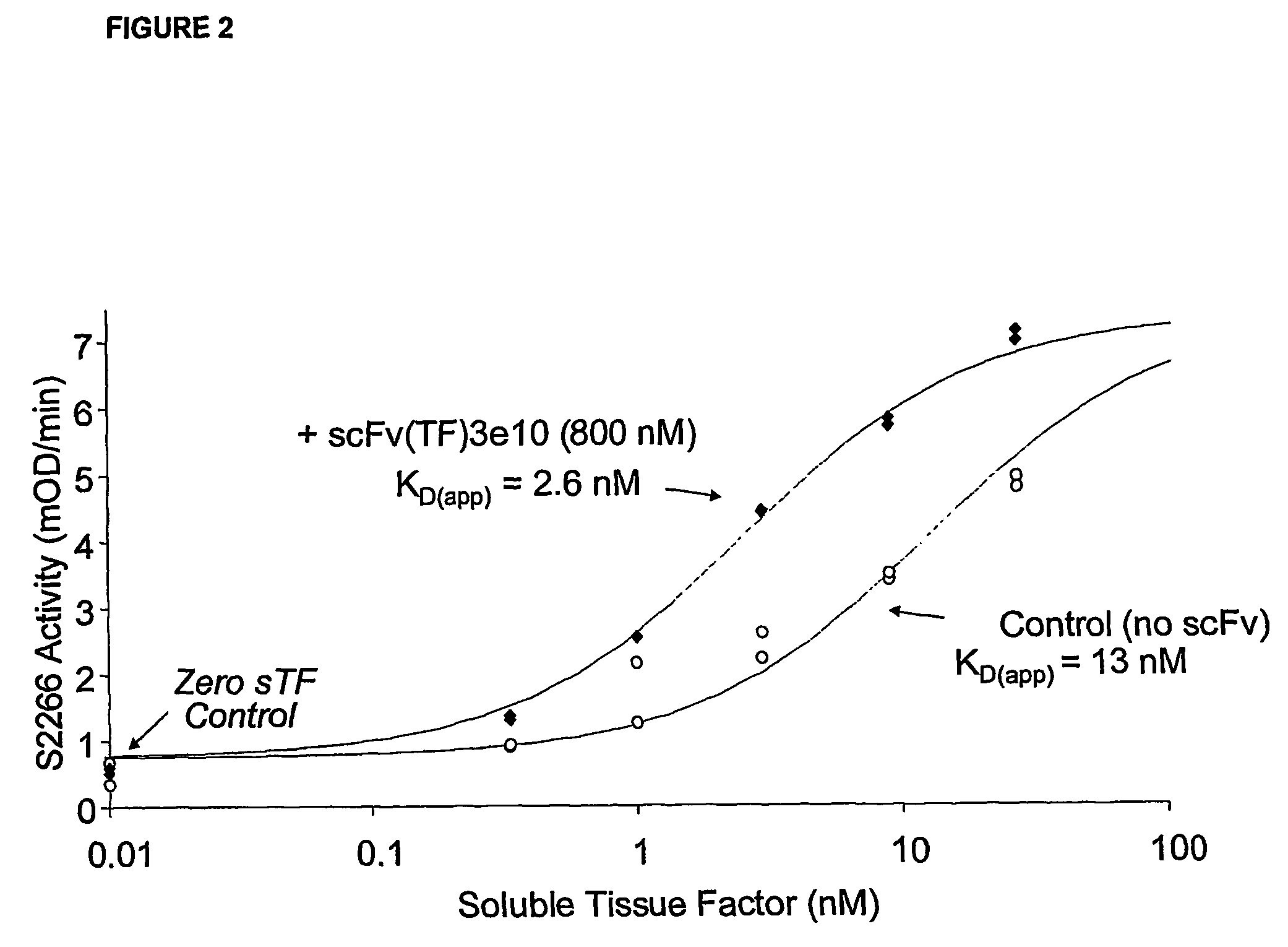Tissue factor targeted antibodies as anticoagulants
a technology of tissue factor and anticoagulant, which is applied in the direction of antibody medical ingredients, instruments, peptides, etc., can solve the problems of rapid formation of fxa and thrombin, life-threatening thrombosis, and/or contribute to pathological complications, and achieve the effect of inhibiting the generation of thrombin
- Summary
- Abstract
- Description
- Claims
- Application Information
AI Technical Summary
Benefits of technology
Problems solved by technology
Method used
Image
Examples
example 1
Single Chain Anti-TF Antibody Construct scFv(TF)3e10
[0126]
(−18) M L G V L V L G A L A L A G L V F P E M A QV N L R E S G G T L V Q P G G S L R L S C A A SG F S F T D A W M S W V R Q A P G K E L E W V SS I S G S G G S T Y Y A G S V K G R F T I S R DN S K N T L Y L Q M N S L R A E D T A V Y Y C AR V L S L T D Y Y W Y G M D V W G Q G T L V T VS A G G G G S G A P N F M L T Q P H S V S A S PG K T V T I S C T R S S G S V A S Y Y V Q W Y QQ R P G S S P T T V I Y E D N H R P S G V P D RF S G S I D T S S N S A S L T I S G L K T E D EA D Y Y C Q S Y D S N N L V V F G G G T K L T VL G A A A G A P V P Y P D P L E P R A A (264)
[0127]The single chain anti-TF antibody scFv(TF)3e10 (SEQ ID NO:1) consists of a signal peptide (−18 to ...
example 2
Single Chain Anti-TF Antibody Construct scFv(TF)3e10Δ
[0128]
(−18) M L G V L V L G A L A L A G L V F P E M A QV N L R E S G G T L V Q P G G S L R L S C A A SG F S F T D A W M S W V R Q A P G K E L E W V SS I S G S G G S T Y Y A G S V K G R F T I S R DN S K N T L Y L Q M N S L R A E D T A V Y Y C AR V L S L T D Y Y W Y G M D V W G Q G T L V T VS A G G G G S N F M L T Q P H S V S A S P G K TV T I S C T R S S G S V A S Y Y V Q W Y Q Q R PG S S P T T V I Y E D N H R P S G V P D R F S GS I D T S S N S A S L T I S G L K T E D E A D YY C Q S Y D S N N L V V F G G G T K L T V L G AA A G A P V P Y P D P L E P R A A (243)
[0129]The single chain anti-TF antibody scFv(TF)3e10Δ (SEQ ID NO:3) consists of a signal peptide (−18 to −1), VH...
example 3
Expression of the Anti-TF Antibodies in Bacterial and Mammalian Cells
[0130]Six different single chain antibodies, scFv(TF)2c1, scFv(TF)2c11, scFv(TF)2d3, scFv(TF)2h6, scFv(TF)3e10 and scFv(TF)3h2, were identified from TF-binding phage, over-expressed in E. coli, and affinity purified using an e-tag affinity column as described above. The affinities of the six purified antibodies for sTF were measured using BIAcore, and then these antibodies were characterized in the sTF / FVIIa peptide hydrolysis, FX activation, PT, and microcalorimetry assays described under Example 4, the results of which are described under Example 5.
[0131]The scFv(TF)3e10 antibody (SEQ ID NO: 1) was also expressed in CHO cells. The expression plasmid contained the DNA sequence encoding scFV(TF)3e10 (SEQ ID NO:2) and both the hygromycin B and DHFR selection markers. Original selection was done in 400 μg / ml hygromycin to select a population. The resulting population was then subjected to 100 nM methotrexate selectio...
PUM
| Property | Measurement | Unit |
|---|---|---|
| pH | aaaaa | aaaaa |
| pH | aaaaa | aaaaa |
| pH | aaaaa | aaaaa |
Abstract
Description
Claims
Application Information
 Login to View More
Login to View More - R&D
- Intellectual Property
- Life Sciences
- Materials
- Tech Scout
- Unparalleled Data Quality
- Higher Quality Content
- 60% Fewer Hallucinations
Browse by: Latest US Patents, China's latest patents, Technical Efficacy Thesaurus, Application Domain, Technology Topic, Popular Technical Reports.
© 2025 PatSnap. All rights reserved.Legal|Privacy policy|Modern Slavery Act Transparency Statement|Sitemap|About US| Contact US: help@patsnap.com



